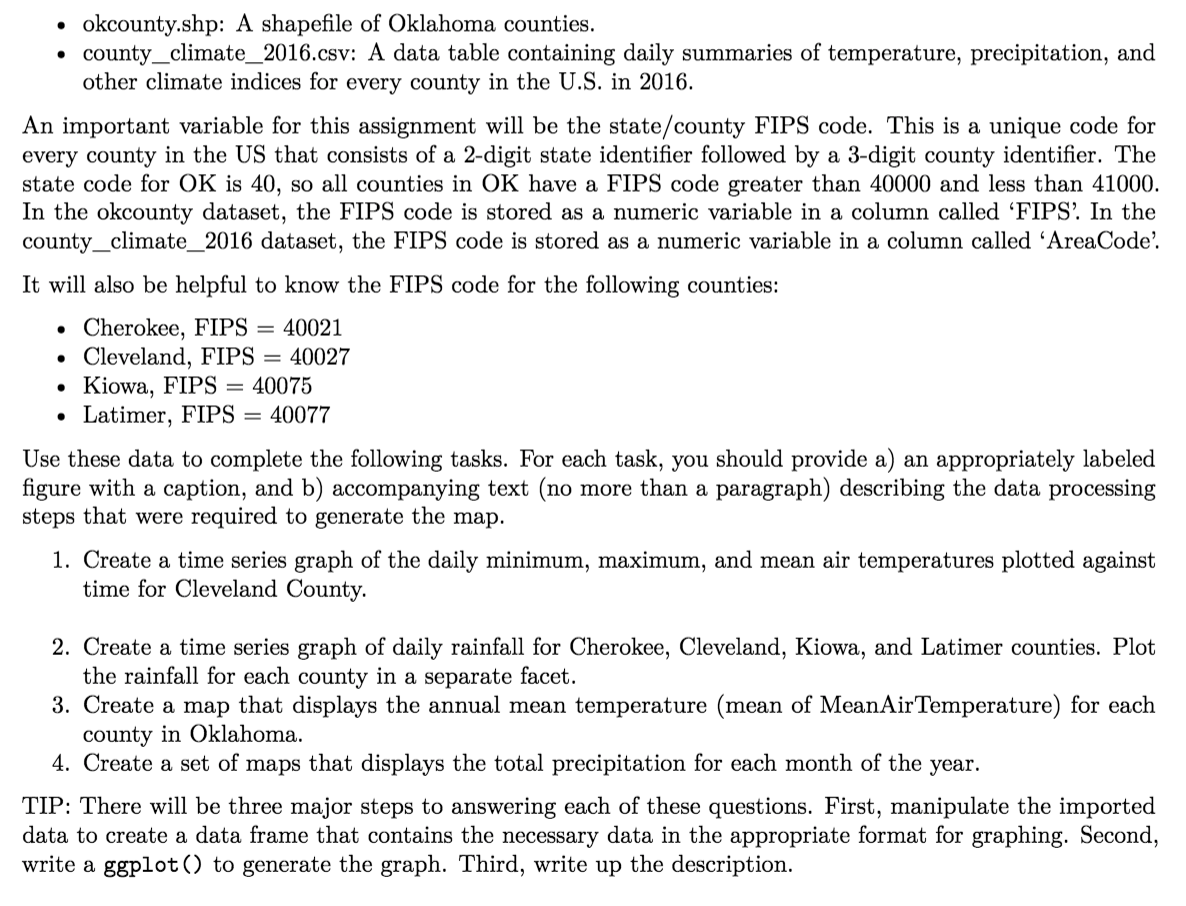
. okcounty.shp: A shapefile of Oklahoma counties. county_climate_2016.csv: A data table containing daily summaries of temperature, precipitation, and other climate indices for every county in the U.S. in 2016. An important variable for this assignment will be the state/county FIPS code. This is a unique code for every county in the US that consists of a 2-digit state identifier followed by a 3-digit county identifier. The state code for OK is 40, so all counties OK have a FIPS code greater than 40000 and less than 41000. In the okcounty dataset, the FIPS code is stored as a numeric variable in a column called FIPS?. In the county_climate_2016 dataset, the FIPS code is stored as a numeric variable in a column called 'AreaCode'. It will also be helpful to know the FIPS code for the following counties: Cherokee, FIPS = 40021 Cleveland, FIPS = 40027 Kiowa, FIPS = = 40075 Latimer, FIPS = 40077 . . . . Use these data to complete the following tasks. For each task, you should provide a) an appropriately labeled figure with a caption, and b) accompanying text (no more than a paragraph) describing the data processing steps that were required to generate the map. 1. Create a time series graph of the daily minimum, maximum, and mean air temperatures plotted against time for Cleveland County. 2. Create a time series graph of daily rainfall for Cherokee, Cleveland, Kiowa, and Latimer counties. Plot the rainfall for each county in a separate facet. 3. Create a map that displays the annual mean temperature (mean of MeanAir Temperature) for each county in Oklahoma. 4. Create a set of maps that displays the total precipitation for each month of the year. TIP: There will be three major steps to answering each of these questions. First, manipulate the imported data to create a data frame that contains the necessary data in the appropriate format for graphing. Second, write a ggplot() to generate the graph. Third, write up the description. . okcounty.shp: A shapefile of Oklahoma counties. county_climate_2016.csv: A data table containing daily summaries of temperature, precipitation, and other climate indices for every county in the U.S. in 2016. An important variable for this assignment will be the state/county FIPS code. This is a unique code for every county in the US that consists of a 2-digit state identifier followed by a 3-digit county identifier. The state code for OK is 40, so all counties OK have a FIPS code greater than 40000 and less than 41000. In the okcounty dataset, the FIPS code is stored as a numeric variable in a column called FIPS?. In the county_climate_2016 dataset, the FIPS code is stored as a numeric variable in a column called 'AreaCode'. It will also be helpful to know the FIPS code for the following counties: Cherokee, FIPS = 40021 Cleveland, FIPS = 40027 Kiowa, FIPS = = 40075 Latimer, FIPS = 40077 . . . . Use these data to complete the following tasks. For each task, you should provide a) an appropriately labeled figure with a caption, and b) accompanying text (no more than a paragraph) describing the data processing steps that were required to generate the map. 1. Create a time series graph of the daily minimum, maximum, and mean air temperatures plotted against time for Cleveland County. 2. Create a time series graph of daily rainfall for Cherokee, Cleveland, Kiowa, and Latimer counties. Plot the rainfall for each county in a separate facet. 3. Create a map that displays the annual mean temperature (mean of MeanAir Temperature) for each county in Oklahoma. 4. Create a set of maps that displays the total precipitation for each month of the year. TIP: There will be three major steps to answering each of these questions. First, manipulate the imported data to create a data frame that contains the necessary data in the appropriate format for graphing. Second, write a ggplot() to generate the graph. Third, write up the description







